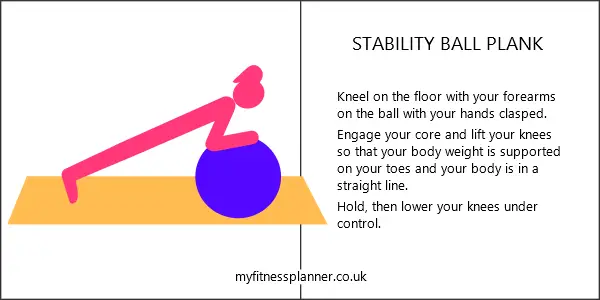An exercise ball (also called a stability ball, gym ball or Swiss ball) is one of the best pieces of equipment for core training. Even just sitting on an exercise ball has a training effect on the abs, as the core stabilising muscles have to work to compensate for the instability of the ball. This workout is a 30 day daily exercise ball routine for beginners.
How to choose the right size exercise ball
For comfort, safety and best training results you should choose the right size exercise ball for your height. See an exercise ball buying guide here.
Exercise ball for beginners challenge
Before you do this challenge, please read these general exercise guidelines. Please also be aware that static exercises like the plank hold are not suitable for anyone with high blood pressure. This is because holding muscles in a static contraction can cause blood pressure to rise. If you have high blood pressure, then leave the plank exercise up.
For the glute bridge exercise, you’ll need some sort of cushioning for your spine, ideally an exercise mat. See an exercise mat buying guide here.
Exercise instructions



Doing the challenge
The chart shows the number of repetitions/hold time in seconds for each day.
Benefits of using a stability ball for core training
- Improved Core Strength: Stability balls engage multiple muscle groups simultaneously, including the abdominals, obliques, lower back, and hip flexors. Performing exercises on the unstable surface of the ball requires the core muscles to work harder to maintain balance and stability, leading to greater strength gains over time.
- Enhanced Balance and Coordination: Balancing on a stability ball challenges your proprioception and neuromuscular coordination, as your body constantly adjusts to maintain stability. This helps improve overall balance and coordination, which are essential for preventing falls and enhancing athletic performance.
- Improved Posture and Spinal Alignment: Using a stability ball encourages proper spinal alignment and posture during exercises, which is essential for reducing the risk of back pain and injury. By strengthening the muscles that support the spine, you can alleviate stress on the lower back and improve overall spinal health.


